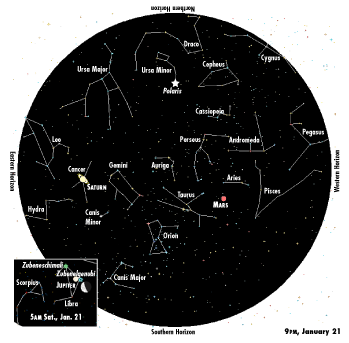 |
||||||||||||||||||||||||||||||
|
||||||||||||||||||||||||||||||
|
The Heavenly ScalesFrom a weigher of souls to the stalwart of libertyThe waning moon rises after midnight this week and reaches last-quarter phase Saturday. Monday morning the moon rises in the southeast around 1:30am with Jupiter trailing less than 10 degrees behind. The following morning, Jupiter leads the way, rising around 2am with the moon following by 10 degrees. On both Monday and Tuesday, look for the moon and Jupiter directly above the southern horizon as daybreak approaches, around 7:20 this week. Shining brighter than any star, Jupiter provides an easy landmark to spot Libra, one of the faintest zodiacal constellations. Between now and June, Jupiter travels within the faint outline of the celestial scales and is currently barely one degree to the east of second-magnitude, bluish-white star Zubenelgenubi, the fulcrum of the scales. The north corner of the scales is marked by dimmer Zubeneschimali, the only green star visible to the unaided eye. In the days of ancient Babylon, nearly 4,000 years ago, the sun passed through Libra during autumnal equinox, when day and night are equal, and so, the Babylonians worshiped this constellation as the Ereshkigal, the goddess of the dead who weighed the souls of men. The Egyptian god Anubis, too, held the scales weighing life and death. The ancient Greeks, however, considered Libra but a part of Scorpius, its stars representing a lamp or lantern and later the lighthouse of Alexandria, held between the scorpion’s outstretched claws. But the Romans wrested the scales from the scorpion, giving them to Astraea, the goddess of justice. She wore a crown of grain, another symbol tied to the scales of early commerce, and she represents purity and innocence. Astraea was the last of the gods to leave earth during the Golden Age. She became Virgo, to the west of Libra, leaving her scales behind as a final gift to mankind. Today, we Americans know her as Lady Liberty. |
|||||||||||||||||||||||||||||
|
|
||||||||||||||||||||||||||||||
|
© COPYRIGHT 2004 by New Bay Enterprises, Inc. All rights reserved. |

